
If you have never bought a guitar pedal and are considering purchasing one (or more), then read on!
Are you planning to take the step soon and purchase your first guitar pedal, then you might just get a lot of choice stress. At the moment, the range of guitar pedals is huge and you will soon no longer see the trees for the forest. To make the choice a little easier, below is an overview of different categories of pedals.
Index
Tips for your first guitar pedal
Before you start looking for your first guitar pedal, some general tips. First of all, it is good to know that the vast majority of pedals are sold without an adapter. You will therefore have to buy an adapter yourself. The type of adapter you need is always stated in the manual or on the pedal. In 90% of the cases you need a so-called 9 volt, center negative, Boss-type adapter. You also always need an extra instrument cable. The sound goes from your guitar to the pedal and from your pedal to your amp. If your amp has an effect loop, you can also use it (for some pedals). In that case you need 2 extra instrument cables. That said, let’s take a look at what categories of effects pedals there are at the moment.
Gain
In this first category are guitar pedals that distort the guitar sound in some way. It is the category of effects that is most popular and not just among guitarists and bassists. Distortion occurs when you increase the volume of a signal so that it exceeds a threshold (headroom). As a result, the peaks of the signal are flattened and all kinds of (harmonic) overtones are created. To our ears that sounds like a rougher, ripping sound, and often as warmer and more expressive. What exactly the difference is between fuzz, overdrive and distortion has already been described in an earlier article, they are all three forms of distortion.
Fuzz
Fuzz is the oldest form of distortion that arose by accident in 1961 with the song “Don’t Worry” by Marty Robbins where a mixer with a broken channel strip was used to record a bass guitar. Sound engineer Glen Snoddy later turned it into a commercial product and called it Maestro Fuzz-Tone. Four years later, in 1965, fuzz became popular with the intro to Satisfaction by the Stones. This gave rise to some very famous fuzz pedals, including the Tone Bender (1965) and the Dallas Arbiter Fuzz Face (1966).
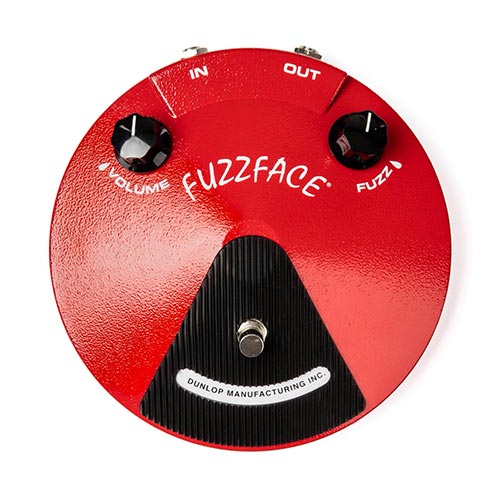
The Fuzz Face is arguably the most iconic fuzz pedal of all time and it’s still being made today. Dunlop has taken over the trademark and produces many variants. We are fans of the big red, the Dunlop Fuzz Face JDF2.
Overdrive
Of the three types of overload, overdrive is the mildest variant. It is based on the sound of an overdriven tube amp. It’s a dynamic form of distortion that often responds very well to your playing. This means that if you play certain notes hard, they will also be distorted more than notes you play softly. And if you turn down the volume of your guitar, the degree of distortion will also decrease. Many consider the 1976 Maxon OD-880 to be the first true overdrive. Not long after, Boss released the famous OD-1. Many pedal makers will later use this circuit as the basis for their own overdrive pedal. There are now countless overdrives on the market, which may or may not be based on classic circuits.
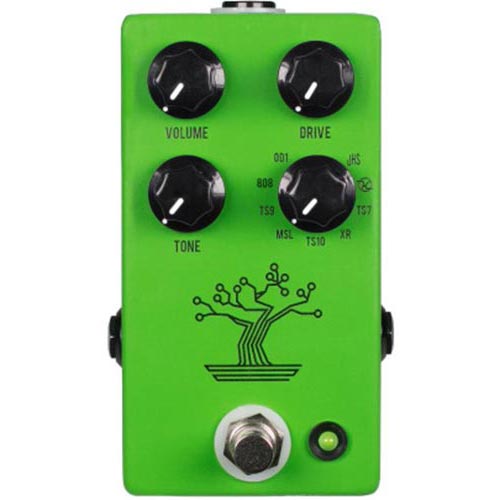
The Ibanez Tube Screamer is one of the most famous and popular overdrives ever. It is an overdrive pedal with a very recognizable sound. It mainly amplifies the midrange of your guitar signal. The JHS Bonsai is a tribute to the Tube Screamer. It has a dial that lets you cycle through as many as nine classic, vintage, rare, or hard-to-find variations of the Screamer.
Distortion
Distortion is somewhere between fuzz and overdrive in terms of distortion. A distortion pedal has more distortion than an overdrive and often slightly less than a fuzz. But there are also distortion pedals that cannot be classified as such. Distortions often use hard clipping, where the signal is cut off sharply, as it were, and it often sounds a bit sharper than, for example, an overdrive. With a distortion pedal you often have a little more control over your sound, especially the low end. In 1973, MXR released the Distortion+ pedal, about the same time as Dan Armstrong’s Blue Clipper. Not long after, the Boss Distortion DS-1 (1978) and the ProCo Rat (1978) followed.
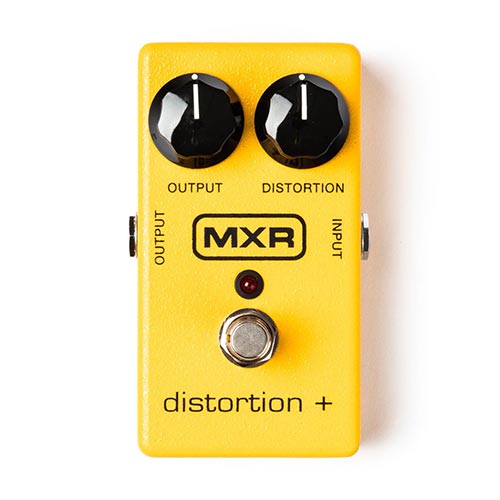
The MXR Distortion + is still being made and is still considered by many to be one of the best distortion pedals on the market. The pedal produces classic hard rock sounds from the early 80s and there are few other distortions on the market that sound quite like this Distortion+.
Overview of fuzz guitar pedals Overdrive guitar pedals overview Overview of distortion guitar pedals
Volume and boost
The second category of guitar pedals are based on volume. These are pedals with which you can make your guitar louder or softer with your foot. Why would you want that at all? This is useful for a number of reasons. First of all, you can use the pedal as an effect. For example, with a volume pedal you can take the attack off your note and make your guitar sound swell, making you sound like a violin. In addition, you can quickly play certain passages at a lower or higher volume without having to use your hands for this. You can also set a pedal to a certain (higher) volume and use it when you have a solo. This is often more convenient than with your guitar’s volume knob. And finally, you can use such a pedal to overdrive your tube amp (a little bit), which often makes it sound better.
Volume
A volume pedal is a pedal that allows you to infinitely adjust the volume of your guitar with your foot. The pedal takes over the function of the volume knob of your guitar. Volume pedals are often made in such a way that your guitar does not sound louder, but softer. Some also don’t require power to work. You can connect a volume pedal before and after other pedals. Connecting it before other pedals controls only the volume of your guitar going to these pedals, connecting it after other pedals controls both the volume of your guitar and the volume of the effects connected before the pedal.
Boost
Another variant within this category is the boost pedal. These are pedals where you can set the volume to a fixed value. With a boost you can almost always set a higher volume than the volume of your guitar. You can make your guitar sound louder with a boost pedal. There are so-called clean boost pedals that only increase the volume, there are treble boost pedals that make a certain frequency range (midrange) sound louder and there are boosts that also allow you to slightly increase the gain (overdrive) of your guitar.

Well-known guitarists such as Jimmy Page and Eddie van Halen used the preamp of an EP-3 Tape Echo as a boost. Xotic has created a boost pedal based on this circuit. It is one of Xotic’s best-selling pedals, the Xotic EP Booster. You can add up to 20 decibels of volume. The pedal has two internal switches with which you can emphasize different frequencies.
Amplitude
The third category of guitar pedals has to do with the course of your guitar signal. This is also called amplitude. Every sound signal has a certain course. The first is the attack, the time in which the note goes from silence to maximum volume level. Then a period called decay is the time during which the note goes from maximum volume to “sustain.” Then the note enters a period of sustain, the constant volume level of the (sustained) note. And finally there is a period of release, the time when a tone dies out. This course is also called ADSR (after the first letters of the different stages). Dynamics is the difference between the softest tones and the loudest (loudest) tones of your guitar. Another word for dynamics is also volume difference.
Envelope
Guitar pedals that influence the course of your signal are called envelope (shaper) pedals. They are pedals that influence the course of your signal by changing one of the stages. In most cases these are pedals that influence the attack or the release. If you adjust the attack of your guitar signal and choose, for example, to let your guitar sound swell slowly, the whole character of the instrument changes. Sometimes even to such an extent that you won’t recognize it as a guitar anymore.
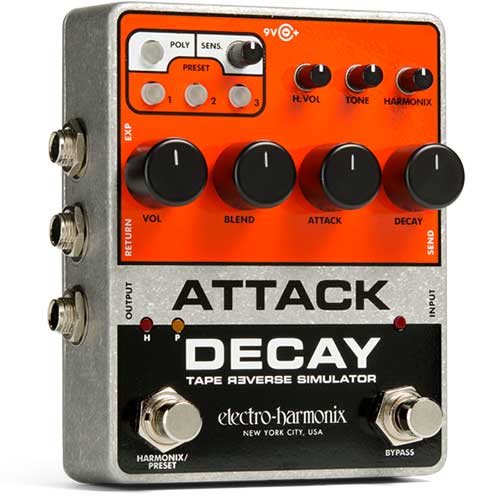
Perhaps the most famous pedal is the Electro Harmonix Attack Decay. The pedal came on the market in 1980 and was recently re-released as a reissue. The pedal allows you to adjust the attack and decay. Furthermore, you can use the pedal polyphonically (the original only worked with single notes) and there is a button with which you can add fuzz.
Compressor
Compressors also fall within this category. A compressor pedal ensures that the dynamics of your signal becomes smaller. Loud passages become less loud and soft passages become less soft. Compressor pedals are often used to make the signal sound smoother or to create extra sustain. A dying note is gradually made louder by the compressor, making it sound as if the note remains at an even volume level. There are many different ways a compressor can do its job. Most pedals use a technique where the compression occurs fairly quickly (Operational Transconductance Amplifier).
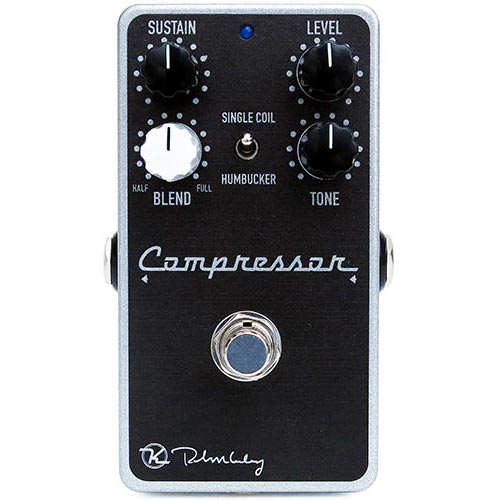
There are many famous compressor pedals. One of the most popular, and has now sold over 80,000 times, is the Keeley Compressor Plus. This pedal is considered by many to be the standard. The pedal has a Blend knob that allows you to mix your original signal with the compressor effect. This is done to maintain the attack of your signal. Meanwhile, many other compressor pedals have the same capabilities.
Frequency
The fourth category of pedals do something with the frequencies of your guitar signal. Frequency is a physical term defined as the number of vibrations per second of sound. Frequency is expressed in Hz (Hz). As a listener we perceive frequencies and often we call this the pitch (for sounds with only 1 tone). When several tones are heard, we are often talking about low frequencies, middle and high or timbre in a general sense. With (electric 6 string) guitars the frequency range is around 80 (low E string) and 6000 Hz (highest note of 1350 Hz including all overtones).
EQ
EQ (Equalization) pedals control the different frequencies of a signal. An EQ pedal is in fact a small mixer with which you ‘color’ the signal to taste. In addition to EQ pedals, there are also many pedals that have an EQ section as standard. Almost all overdrive pedals have a Tone knob as standard with which you can adjust the timbre. EQ pedals come in roughly three forms: shelving – which lets you make small adjustments to high or low ranges, parametric – specific adjustable frequency ranges where you can also set the width of the range, and graphic – pre-selected frequency ranges. Furthermore, it is good to know the difference between passive EQ – you can only remove volume in a frequency range and active EQ – you can also add volume in a frequency range.
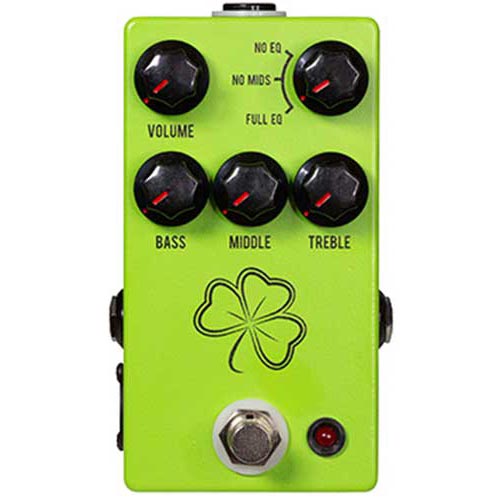
The JHS Clover is a pedal that allows you to adjust the low, middle and high of your signal. In addition, the pedal has a volume knob with which you can adjust the sound level and a DI output with which you can connect the signal directly to a mixer or sound card.
Filter
You can radically shape your guitar signal with a filter. A filter ensures that you no longer hear certain frequency ranges at all. You filter these areas out of your signal. The three most commonly used types of filters are: LPF (Low Pass Filter), HPF (High Pass Filter) and BPF (Band Pass Filter). With an LPF you filter out the high tones, with an HPF you filter out the low tones. A BPF provides filtering of both high and low tones, leaving you with a certain frequency range (the frequency range in between). Often filters are not used statically but in combination with movement whereby the frequency range that is filtered varies. In addition, resonance (also called Peak or Q on pedals) is very common on filter pedals. Resonance can be regarded as the character of the filter.
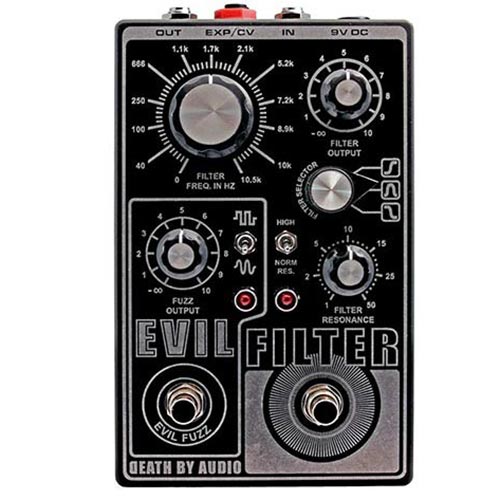
There are not a lot of separate filter pedals except for the Wah Wah (see below). There are many pedals that use filtering. Chase Bliss used to make the Condor and Death By Audio Evil Filter is a radical pedal that allows you to hear the effect of filtering well. The pedal is also a fuzz.
Wah
A category of effects that is very well known to guitarists, which is based on the Band Pass Filter, is the Wah Wah. Although originally intended for trumpet players, the effect has become known mainly by guitarists such as Jimi Hendrix. The pedal is actually a filter that you operate with your foot. You constantly adjust the filter with your foot and you would create the characteristic Wah effect. The most important part of a Wah is the coil (inductor). The coil provides the frequency range and character of the effect. The two main inductors are the Halo (used in the Vox Wah) and the Fasel (found in the Dunlop Cry Baby)

The Dunlop Cry Baby is by far the most famous Wah pedal in the world. There are now many variants on the market and many famous guitarists have a signature Cry Baby. The original is still being made and is still one of Dunlop’s most popular pedals. If you’re looking for your first guitar pedal, this might be it!
Talk
Finally, there are also so-called talk and vocoder pedals within this category. Talk pedals (the effect used by Peter Frampton in Show me the Way and Richie Sambora in Living on a Prayer) build on the vocal effect of a wah wah pedal. With a talk pedal you actually produce the effect with your mouth. A talk pedal is actually a speaker that carries the signal through a tube to your mouth. You create the effect with your mouth, which is then amplified by a microphone. In addition to talk pedals, there are also vocoder pedals for guitar. These are pedals that produce approximately the same effect electronically. Here you create the effect with buttons and not with your mouth.
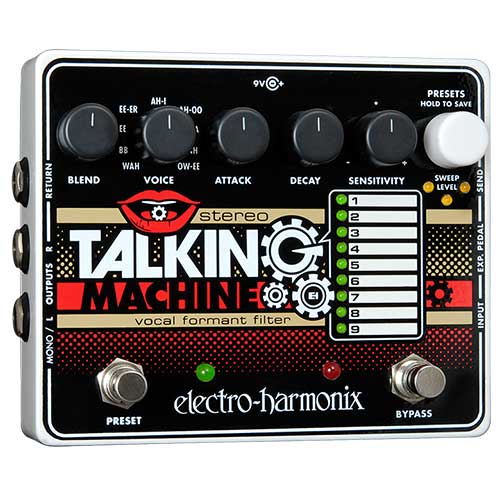
Talk and vocoder pedals never really became popular like wah wah pedals are. There are also not many manufacturers that still market them. Electro Harmonix has an extensive Vocoder pedal, the EHX V256 Vocoder and in addition there is the EHX Stereo Talking Machine. With this last pedal you can choose different vocal sound options such as AH-OO, EE-ER or OW-EE. The pedal is based on 2 Band Pass Filters and is stereo.
Time
The fifth category of effect pedals is based on time. They are pedals that manipulate time, stretch time, create repetitions in time, freeze time or use time to create space. Along with effects based on distortion and modulation (see below), it is one of the most popular category of guitar pedals. Almost every manufacturer has one or more pedals that fall into this category.
Delay
First of all there is the delay pedal. A delay produces an (exact) copy of the sound that goes into it and plays this copy a little later. In colloquial speech we call this an echo, in an echo well you hear yourself talking a little later. A delay pedal does that too, but with your guitar signal, it delays it to a later moment. Delay pedals come in all shapes and sizes, you can roughly distinguish them into three different types: tape, analog or digital. There are hardly any real tape delays in pedal form, but there are many pedals that mimic the effect. However, there are plenty of analog and digital delays. An analog delay pedal has more warmth (some loss in treble) than a digital delay, producing an ‘exact’ copy. But today many digital delays have capabilities to create that warmth digitally.
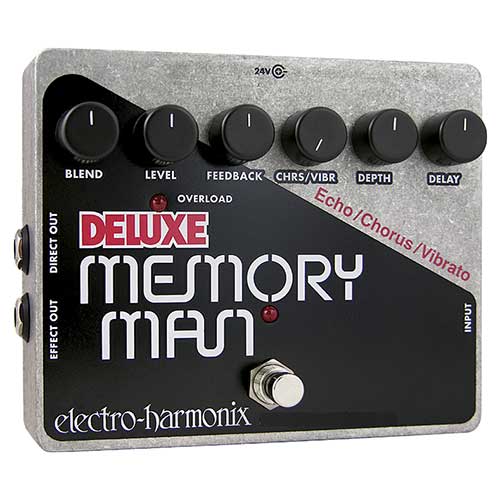
One of the most famous analog delays is the Deluxe Memory Man from Electro Harmonix. The Memory Man was released in 1976 and has since been used by many famous guitarists. Think U2’s The Edge and Radiohead’s Ed O’Brien. Many variants have also been introduced to the market. One of the most popular variants, however, remains the Deluxe Memory Man, which also includes the option to modulate echoes.
Reverb
Reverb or reverb is another very popular guitar pedal that is based on ‘time’. A reverb pedal creates space by dividing the signal into very many small echoes of different lengths. These echoes and the unprocessed signal are then mixed and this creates a whole with which a space is recreated. Editing rooms with EQ gives you different types of reverberations known by names like Room, Hall, Plate. Almost all Reverb pedals are digital because a lot of processing power is required for this effect. A number of manufacturers make reverb pedals based on the coil spring found on some tube amps. They are often called spring reverb.
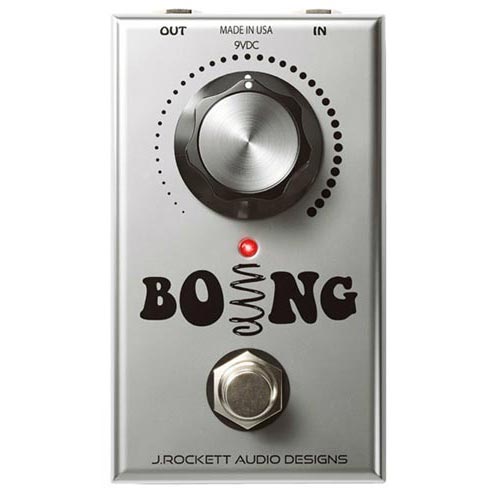
The J Rockett Boing is based on the reverberation of some Fender tube amps . A coil spring reverb is a popular effect that can be heard on many popular songs. The Boing is not a complicated effects pedal with only one button: intensity. It’s also a nice big button, so you can even operate it with your foot. Handy if you need a little more or less reverb in a live performance.
Freeze
Freeze pedals do something special with time, because they stop it. A small portion of the guitar signal is copied and repeated endlessly (until you turn off the pedal). This is also where the name of this category comes from, the sound is as it were frozen in time. There are pedals that can only freeze a few passages and there are pedals that can freeze multiple layers that allow you to create a kind of sound carpet.
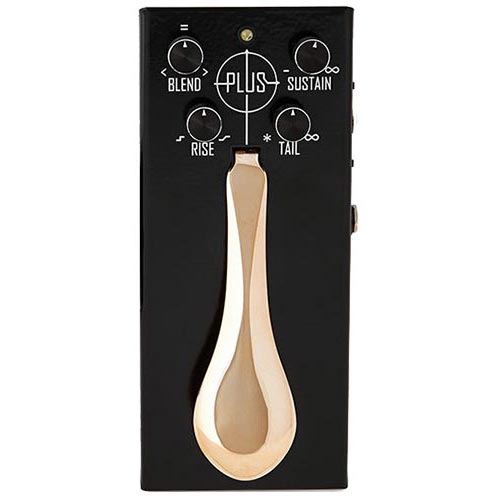
The Gamechanger Audio Plus pedal is a special freeze pedal with which you can freeze the sound with your foot. The pedal looks exactly like a sustain pedal on a piano and also has the same function. There are also knobs with which you can set the start (rise) and end (tail) and the extent to which the effect is mixed with the raw guitar sound (blend).
Looper
Finally, looper pedals also fall into this category. With a looper you can quickly record your guitar and play it back. You can work out musical ideas with it or you can use it on stage to accompany yourself (like Ed Sheeran does, for example). Looper pedals come in all shapes and sizes, from the very simple to elaborate, colossal variants that allow you to manipulate just about any part.
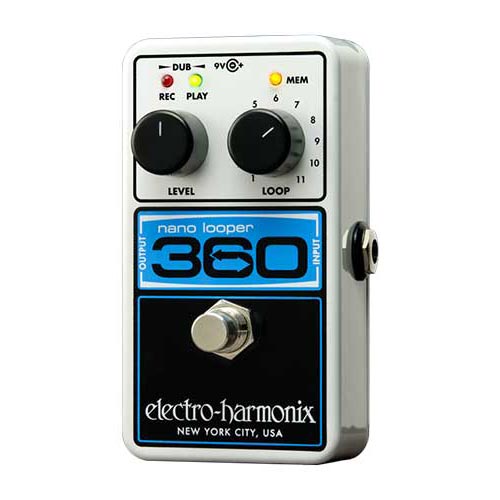
The Electro Harmonix Looper 360 is a simple looper pedal that 360 seconds (6 minutes) of recording. These 6 minutes are divided into 11 separate loops that you can reach with the Loop knob. This makes loop recording and then overdubbing a breeze.
Modulation
The sixth category of effects has many different variants, the common element of these variants is modulation. Modulation is the automatic (cyclical) movement of a part of an effect. For example, a tremolo pedal is based on the effect of volume getting louder and softer with a certain speed. Modulation has to do with motion and modulation effects very often use modulation at relatively low speeds. The most well-known modulator is a so-called low frequency oscillator (LFO). Almost all pedals that are based on an LFO have buttons with which you can set the speed (speed) and depth (depth).
Tremolo
The first pedal in this series is the tremolo pedal. As mentioned above, this is a modulation pedal based on constantly repeating variation in volume. The effect gets harder and softer in a constant and cyclical pattern. Tremolo is also one of the oldest effects. One of the first tremolo effects is from 1941 and comes from DeArmond, in the 1950s Fender started adding tremolo to Fender amps.
In addition to traditional (volume) tremolo pedals, there are also so-called harmonic tremolo pedals. In a harmonic tremolo pedal, the guitar signal is divided in two into a high and a low part. The volume of both the high and low frequencies is modulated in such a way that a part of the signal can always be heard (called ‘out of phase’). The guitar signal will never become completely silent with a harmonic tremolo, unlike a normal tremolo where this does take place.
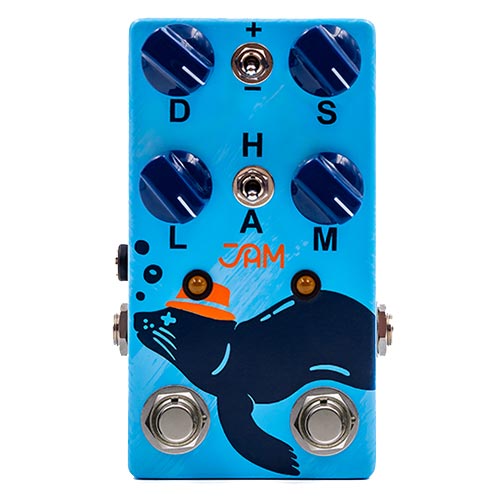
One of the best harmonic tremolos out there is the Jam Pedals Harmonious Monk. The pedal sounds great and has some nice features. First of all, the pedal has two switches, which let you choose a subtle effect or an intense effect with stuttering, staccato pulses that add drama to your music. In addition, there is an extra foot switch, with which you have direct access to two speeds. The pedal also has three internal knobs that allow you to shape the EQ to your liking, and the ability to increase or decrease the overall output level.
Vibrato
A vibrato pedal produces an effect in which the pitch of the guitar signal fluctuates constantly with a certain depth and speed. Vibrato occurs naturally with the use of tapes (magnetic tapes) that age. The playback speed of tapes fluctuates slightly which creates a kind of floating effect. Almost all vibrato pedals have a knob with which you can adjust the depth (the degree to which the pitch deviates from the original) and a knob with which you can adjust the speed of the effect.
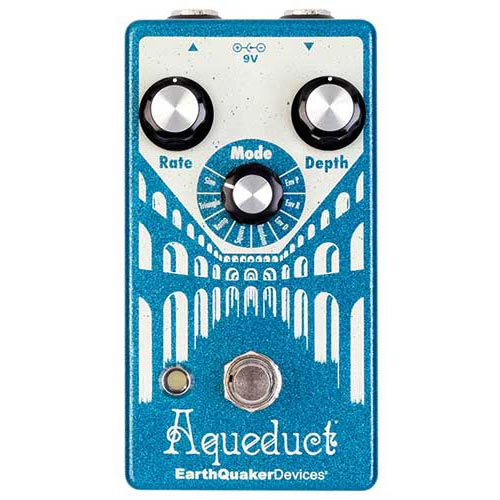
Compared to many other effects, there are relatively few vibrato effects. The effect is often on chorus effects, you can read why that is below. Earthquaker Devices Aqueduct is a vibrato effect with different preset modes. The first five presets contain different waveforms for the LFO that controls the vibrato effect. The last three presets contain a number of touch-sensitive modes with which the effect is controlled by the force with which you play your strings.
Chorus
Chorus is unmistakably linked to the 80s of the next century, it is the sound of the 80s. The chorus effect occurs when you combine the vibrato effect described above with the original, unprocessed signal. Combining both signals creates a wall-to-wall effect that makes it seem like multiple guitarists are playing simultaneously. Many chorus effect pedals have a mix knob that lets you mix the processed (vibrato) signal with the original, unprocessed signal. Turn this knob all the way up (or down, depending on how the knob works on the pedal) and you’ll hear only the (vibrato) effect.
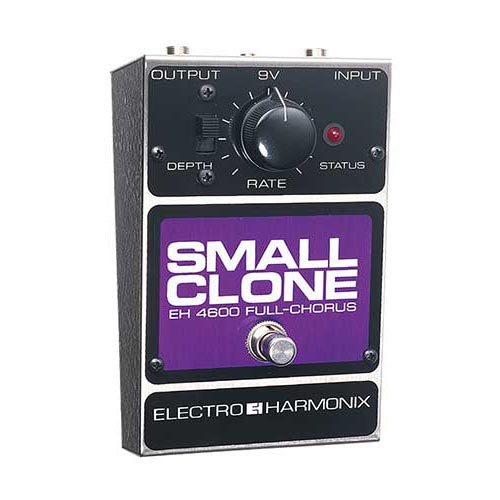
There are many chorus effects, a well-known effect that is particularly associated with Curt Kobain is the Electro Harmonix Small Clone. The effect is from 1979 and is still made by Electro Harmonix. It is an extremely simple pedal with only one knob – Rate and a switch – Depth. With the Rate knob you set the speed and with the Depth switch you can choose how much of the effect you hear (little or much).
Flanger
Then we arrive at an effect that is sometimes confused with chorus by some. In terms of sound, it also has something to do with it. A flanger is an effect in which the original signal is copied and delayed. The delay is then modulated, often by an LFO. This causes so-called comb filter effects. Flanging was already used in the 1950s in studios and by Les Paul, but the term originated in 1966 and originated in the Abbey Road studio. Touching the edge of one of the reels (flange) while playing two tapes with the exact same signal temporarily slowed that reel, causing a short delay. The flange effect was created by mixing both tapes back together.

A good flanger with a very favorable price/quality ratio is the Foxgear Maitresse. The sound of this flanger is somewhere in between chorus and flanger. It is a pedal with three knobs: Feedback, Rate and Depth. The Feedback knob is for the amount of feedback, turn this knob all the way to the right and self-oscillation will occur. Use the Rate knob to set the speed of the flanger effect. The Depth knob controls the depth of the effect.
Phaser
Another modulation effect based on phase differences is the phaser. It is quite similar to a flanger, only the effect is more controllable. A phaser uses filters that control the phase of the signal affects. The number of filters of a phaser determines the sound, the more filters the more comb filtering. A phaser often has less comb filtering than a flanger. The phaser effect is then created by modulating the frequencies. The difference between a flanger and phaser may be a bit complicated to explain, but when you hear it, the differences are clearly recognizable.
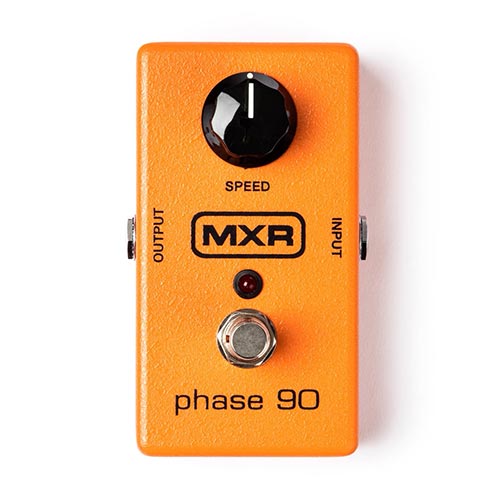
The MXR Phase 90 is still one of the most famous phasers from this moment. The effect was first introduced about 40 years ago and is still used by many famous guitarists, including David Gilmour and Jimmy Page. Eddie Van Halen also loved it and has a special signature version of this pedal.
Ring Modulation
Then we have arrived at Ring Modulation. This is a collection of pedals with a select group of enthusiasts and a (slightly larger) group of people who abhor it. In short, you have to love it. The effect is somewhere between modulation and effects based on pitch. Ring modulation is actually a mathematical effect that uses two signals. The first signal is your guitar sound, we call that the modulator. The second signal is the carrier and is located in the pedal. You can almost always set the frequency of the carrier on the pedal. Then the two signals are both added (sum) and subtracted (difference). These two new signals then come out of the ring modulator. Almost always there is little relationship between the signal that goes in and what comes out and it sounds quite atonal.
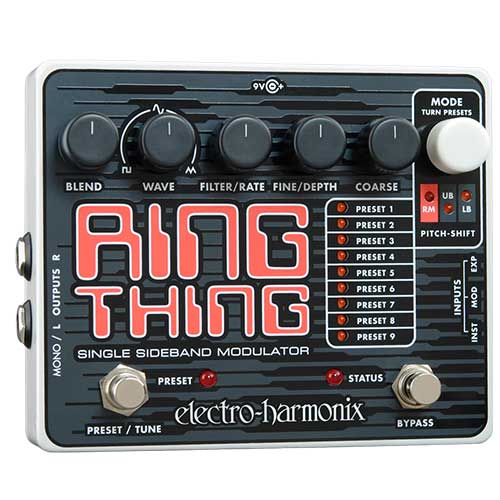
There are not very many ring modulators on the market. The most famous is perhaps that of Moogerfooger. In addition, there is the Electro Harmonix Ring Thing. It is a fairly extensive pedal with which you can create many modulation effects, such as octaves, tremolo and vibrato. You can also create separate and unique effects with it, making the pedal particularly suitable for experimental guitarists.
Vibe
An effect that sounds a bit between chorus and phaser is the vibe. If you’ve never heard a (Uni)vibe, check out Jimi Hendrix’ Machine Gun, or Pink Floyd’s Breathe. The circuit of a vibe has the most similarities with the circuit of a phaser. The difference is in the way the filters are set in a vibe. With a phaser, each filter provides a more or less equal phase shift, with a vibe, each filter is set in such a way that there are different phase shifts in the signal.
Furthermore, you often hear the effect less well at low speeds and that is the reason that vibes often have higher speeds than phasers. The most famous vibe is the Uni-vibe of Shi-Ei. This one has become so well known that many people often refer to a Uni vibe when they mean a vibe (similar to people asking for Spa and wanting spring water).
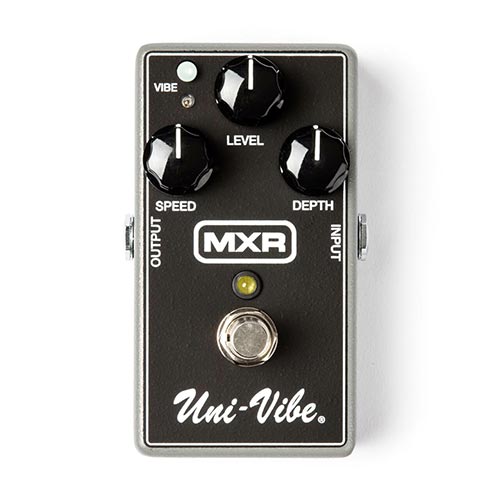
A number of brands have vibe pedals in their range, Fulltone has the Mini Deja Vibe and the MDV-3. Jam Pedals has the popular Retrovibe and then there’s the MXR Uni-Vibe. It’s a pedal that will delight hardcore Uni-Vibe fanatics as well as modern players. It has a simple three-button interface that allows you to set the effect to your liking.
Rotary
The last type in this category is the rotary effect. Rotary pedals are based on revolving Leslie speakers used to enhance the sound of Hammond organs. The speaker consists of two speaker sections, one for the high and one for the low tones. The loudspeakers rotated in the opposite direction at a certain speed. The Leslie had two speeds to choose from, slow and fast. And furthermore, it took some time to switch from slow to fast and vice versa. The effect is still incredibly popular, especially with blues guitarists (and organists of course).

The Strymon Lex is a rotary effect where the effect on a particular authentic way, digitally recreated. The pedal has knobs with which you can adjust the treble and the gain. You can also set the speed (only that of the Fast Rotor) and you can determine the distance of the microphone.
Pitch
The last category of pedals all do something with the pitch of your guitar signal. Pedals in this category add notes, completely change your signal, turn your guitar into a bass, create harmonies, or make you no longer recognize your guitar at all. Almost all pedals in this category use so-called ‘tracking’. Tracking means that a pedal has to recognize the pitch of the incoming signal and then process it. This takes some time (so there is a delay) and not all pedals have an equally good tracking.
Octaver
The first series of pedals add one or more octaves to your signal. An octave is the same note you play but higher (or lower). Thus, the tone is transposed to a higher or lower octave. There are pedals that only add one octave and there are pedals that can add multiple octaves. Most octavers are digital, but there are also analog octavers. These pedals are monophonic, so you can only play 1 note at a time. You often have to adjust your playing slightly because this type of pedal is very sensitive to noise. However, the vast majority of octavers are digital and use tracking to create the effect. Octavers are often used in combination with fuzz or distortion and there are many octave/fuzz pedals.
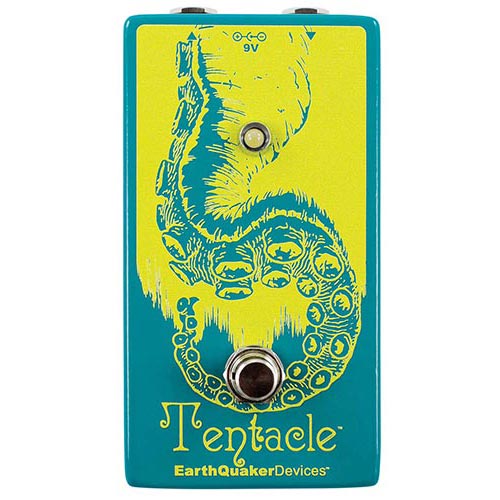
Earthquaker Devices Tentacle is an analog octaver without buttons. The pedal can only do one thing and that is produce an octave higher than the note you are playing. The pedal combines well with fuzz or distortion and produces great sounds.
Pitch Shifter and harmony
If you’re looking for something more than just an octave, use a pitch shifter. With a pitch shifter you can create any interval you want, so not only octaves but also fourths and fifths. On most pitch shifters you set the interval with a knob. You can choose from all intervals from the Western scales: semitone, whole tone, third, fourth, etcetera. With a pitch shifter you mix your guitar signal with the effect and you can play multiple notes, while you only play 1. Many pitch shifters are polyphonic, meaning you can also play chords.
With pitch shifters it is true that the intervals you choose do not automatically mean that they end up in the same key. For this you need a harmony pedal. On a harmony pedal you can also choose the key and all adjustments in pitch are made within the key you choose.
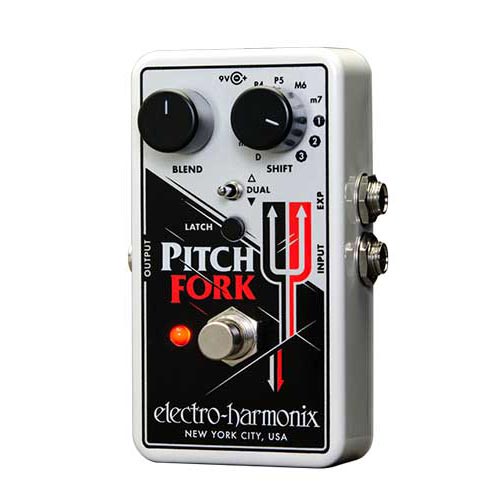
The Electro Harmonix Pitch Fork is a good pitch shifter with which you can make up to three octaves above or below the note you are playing. You can even create 2 simultaneous tones with it when you use the Dual switch. The pedal has good tracking and is also polyphonic.
Overview of pitch shifter pedals
Synth
Then we arrive at the last series of pedals, so-called synth pedals. These are pedals that transform your guitar into something completely different. Synth pedals come in many different forms: pedals that make your guitar sound like a piano, sitar or hammond organ, pedals that use your guitar signal to create an analog synth, and pedals that are instruments in their own right. Most pedals have elements of the way analog synthesizers work. That means one or more waveforms to choose from, filters to process the signal and envelopes to influence the course of the effect.

Most synth pedals are monophonic by the way, an exception to this is the Meris Enzo . This is a polyphonic synth pedal that allows you to create rich and complex soundscapes. It’s arguably one of the best synth pedals out there right now.
Finally
I hope this has given you an overview of the different types of guitar pedals that are currently for sale. There are more types, by the way, but most pedals fall into one (or more) of the above categories. Good luck with your search and if you’ve read this article all the way here, I’d love to hear what you think. Let us know in the comments below. Also, if I’ve missed anything, I’d love to hear about it!
